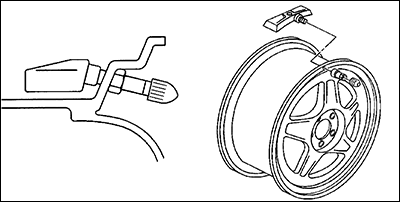2001 Cadillac TPMS
In 2001, Cadillac® introduced a Tire Pressure Monitoring (TPM) system in their DeVille® and Seville® models. This system allows the driver to view each tire's air pressure individually on the Driver Information Center (DIC) and automatically warns the driver of an under-inflated or over-inflated tire by illuminating a "Check Tire Pressure" message. At the core of the system are four uniquely coded air pressure sensors mounted on the inside of the wheels at the valve stems.
The TPM system affords your customers a tool to optimize the ride, safety, handling and gas saving ability of their vehicles. You can do your part by setting the tires to the proper pressure. Verify the recommended air pressure setting by looking at the driver's side rear door for the tire information placard.
TPM System Background
The Tire Pressure Monitor (TPM) system interfaces with the Instrument Panel Cluster (IPC) through a serial data line. Once the program mode is accessed, each sensor's unique identification code can be programmed into the receiver's memory. Each sensor must transmit the unique code in the proper sequence. In order to force the sensor to transmit the identification code, a horseshoe magnet must be held close to the sensor. The receiver also sends a message to the Dash Integration Module (DIM) to sound the horn one time, indicating that the sensor properly transmitted an identification code. If the programming sequence is canceled before any sensor is programmed or if the vehicle's battery is disconnected, the receiver will remember all current identification codes. As soon as the receiver learns the first sensor identification code, all previously stored codes are erased from the receiver's memory.
The components of this system require specific programming and replacement procedures. Here are some important points:
 |
- The TPM system must be reprogrammed any time that the tires are rotated or a wheel mounted air pressure sensor is replaced. If the TPM system is not reprogrammed after tire rotation, the DIC will report the individual tire pressures at an incorrect wheel location.
- If a wheel sensor is replaced, no data will be displayed for that wheel location until reprogramming is completed.
- The wheel mounted air pressure sensors are affixed to the inside rim of the wheel using specific parts. The valve core has a special nickel plating to prevent corrosion on the aluminum wheel. Use only factory GM parts or equivalent high-quality replacement parts.
- During sensor replacement, the attaching nut MUST be tightened to 35 lb in (4 Nm) to ensure a proper seal without damaging the grommet or sensor.
TPM System Update
A change, beginning with VIN # U115021, was made to widen the range of the system for over-inflation. The original system programming displays the "Check Tire Pressure" message if air pressure drops to 24 psi (165 kPa) or rises to 36 psi (248 kPa). The updated programming still lights the DIC message at 24 psi (165 kPa) but extends the upper range to 39 psi (269 kPa) before warning the driver. All current Owner's Manuals state that the "Check Tire Pressure" message will light at 36 psi (248 kPa). If the vehicle is past the above VIN breakpoint you can assure your customer that the system is functioning correctly or give them a copy of this article.
Use the following Service Procedure whenever the tires are rotated, replaced, repaired, serviced, or a wheel sensor is changed. You will need a horseshoe magnet (Kent-Moore tool J-41760 or equivalent) to complete the following steps:
Service Procedure
(Review safety procedures contained in the ALLDATA® system before beginning)
- Turn the ignition to the RUN position, but do not start the vehicle.
- Press and hold the key fob LOCK and UNLOCK buttons simultaneously until a horn chirp is heard. This should happen within ten seconds.
- NOTE: You will have only one minute per step to complete the next four instructions. If any step is not completed within the one minute time limit, the system will leave the programming mode and you will have to begin again from Step 2.
- Go to the LEFT FRONT tire and hold the horseshoe magnet directly over the valve stem until a horn chirp is heard. This should happen within five seconds.
- Go to the RIGHT FRONT tire and hold the magnet over the valve stem until a horn chirp is heard.
- Go to the RIGHT REAR tire and hold the magnet over the valve stem until a horn chip is heard.
- Go to the LEFT REAR tire and hold the magnet over the valve stem until a horn chirp is heard.
- A double chirp after the final tire indicates that the system has been successfully programmed. If you do not hear the double horn chirp, the system did not program properly and you will have to begin at Step 2 again.
- Scroll through the DIC scanner with the mode button to verify that the tire pressures are displayed for all four wheel locations. If any data is missing, repeat from Step 2.
Cadillac® , Seville® and DeVille® are registered trademark names and model designations of the General Motors Corporation and are being used solely for reference and application purposes.
© 2014 ALLDATA LLC. All rights reserved. All technical information, images and specifications are from the ALLDATA Product. ALLDATA is a registered trademark of ALLDATA LLC. All other marks are the property of their respective holders.






